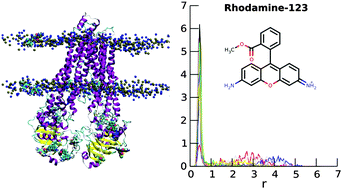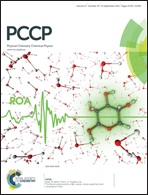Do adsorbed drugs onto P-glycoprotein influence its efflux capability?†
Abstract
The membrane biophysical aspects by which multidrug resistance (MDR) relate to the ABC transporter function still remain largely unknown. Notwithstanding the central role that efflux pumps like P-glycoprotein have in MDR onset, experimental studies classified additionally the lipid micro-environment where P-gp is inserted as a determinant for the increased efflux capability demonstrated in MDR cell lines. Recently, a nonlinear model for drug–membrane interactions showed that, upon drug adsorption, long-range mechanical alterations are predicted to affect the P-gp ATPase function at external drug concentrations of ∼10–100 μM. However, our results also show that drug adsorption may also occur at P-gp nucleotide-binding domains where conformational changes drive the efflux cycle. Thus, we assessed the effect of drug adsorption to both protein–water and lipid–water interfaces by means of molecular dynamics simulations. The results show that free energies of adsorption are lower for modulators in both lipid/water and protein/water interfaces. Important differences in drug–protein interactions, protein dynamics and membrane biophysical characteristics were observed between the different classes. Therefore, we hypothesize that drug adsorption to the protein and lipid–water interface accounts for a complex network of events that affect the ability of transporters to efflux drugs.



 Please wait while we load your content...
Please wait while we load your content...